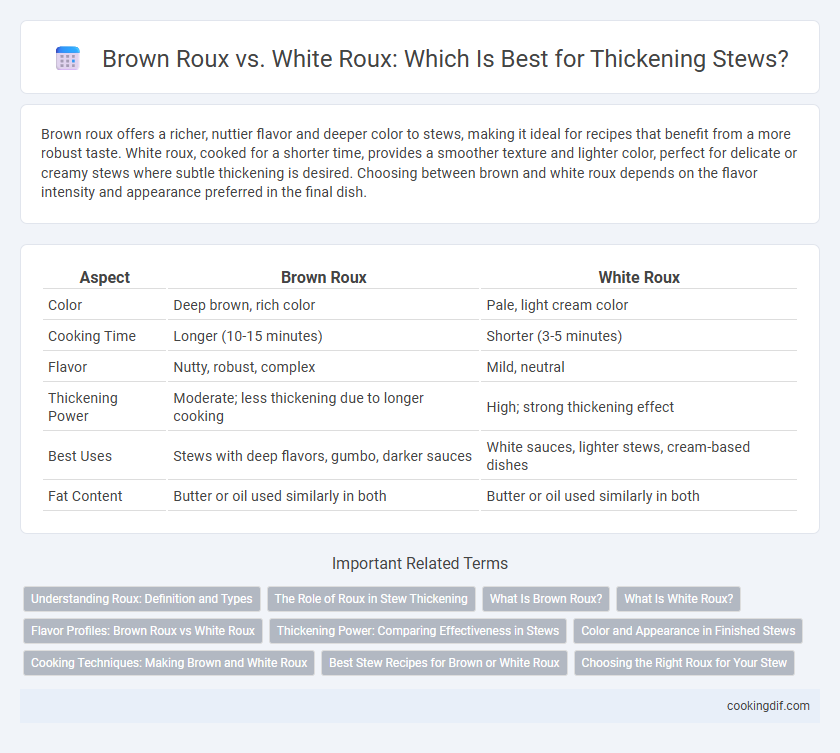Brown roux offers a richer, nuttier flavor and deeper color to stews, making it ideal for recipes that benefit from a more robust taste. White roux, cooked for a shorter time, provides a smoother texture and lighter color, perfect for delicate or creamy stews where subtle thickening is desired. Choosing between brown and white roux depends on the flavor intensity and appearance preferred in the final dish.
Table of Comparison
| Aspect | Brown Roux | White Roux |
|---|---|---|
| Color | Deep brown, rich color | Pale, light cream color |
| Cooking Time | Longer (10-15 minutes) | Shorter (3-5 minutes) |
| Flavor | Nutty, robust, complex | Mild, neutral |
| Thickening Power | Moderate; less thickening due to longer cooking | High; strong thickening effect |
| Best Uses | Stews with deep flavors, gumbo, darker sauces | White sauces, lighter stews, cream-based dishes |
| Fat Content | Butter or oil used similarly in both | Butter or oil used similarly in both |
Understanding Roux: Definition and Types
Roux is a mixture of fat and flour cooked together to create a thickening agent for stews and sauces. Brown roux is cooked longer, developing a rich, nutty flavor with a darker color, ideal for hearty stews, while white roux is cooked briefly to retain a pale color and mild taste, suitable for delicate stews and cream-based dishes. The choice between brown and white roux impacts the stew's flavor depth and color intensity, making understanding these types essential for achieving the desired consistency and taste.
The Role of Roux in Stew Thickening
Roux serves as a fundamental thickening agent in stew, with brown roux offering a richer flavor and darker color due to longer cooking times, which breaks down starches more thoroughly. White roux, cooked briefly, provides a milder taste and lighter hue, maintaining a higher starch content for faster thickening. The choice between brown and white roux directly impacts the stew's texture and depth, balancing viscosity with flavor complexity.
What Is Brown Roux?
Brown roux is a cooked mixture of equal parts flour and fat, typically butter, heated until it achieves a rich, caramelized color and nutty aroma, making it ideal for thickening stews with deeper flavor profiles. Unlike white roux, which is cooked briefly and remains pale for subtle thickening, brown roux requires longer cooking at moderate heat to develop complexity without burning. Its robust taste enhances hearty dishes like gumbo and beef stew, contributing both thickness and a distinctive, toasted note.
What Is White Roux?
White roux is a mixture of equal parts flour and fat cooked briefly until the raw flour taste disappears, retaining a pale color. It serves as a subtle thickening agent for stews without altering the color or flavor significantly. Its light texture and mild taste allow stews to maintain their intended appearance and flavor profile.
Flavor Profiles: Brown Roux vs White Roux
Brown roux offers a deep, nutty flavor and rich color that enhances the complexity of stews, while white roux provides a mild, more neutral taste, allowing the natural ingredients to shine through without overpowering them. The longer cooking time for brown roux develops caramelized notes and smoky undertones, contributing a robust base that intensifies the stew's overall depth. White roux's shorter cooking process results in a subtle, creamy texture that thickens without altering the stew's original flavor profile significantly.
Thickening Power: Comparing Effectiveness in Stews
Brown roux has a stronger thickening power than white roux due to its advanced cooking process which breaks down starches more fully, making it ideal for rich stews. White roux, cooked lightly and for a shorter time, retains more raw starch, providing a quicker but less intense thickening effect. For stews requiring deep flavor and glossy texture, brown roux offers superior effectiveness in thickening compared to white roux.
Color and Appearance in Finished Stews
Brown roux imparts a rich, deep color to stews, enhancing the overall appearance with a warm, caramelized hue that signals robust flavor development. White roux, being lighter and less cooked, maintains a paler color in the finished stew, resulting in a creamier, more subtle visual appeal. Choosing between brown and white roux directly influences the stew's final color intensity and perceived taste complexity.
Cooking Techniques: Making Brown and White Roux
Brown roux develops a deeper, nuttier flavor and is cooked longer until it achieves a rich brown color, ideal for stews requiring robust taste and thicker consistency. White roux cooks briefly just enough to eliminate the raw flour taste, maintaining a pale color and providing a mild thickening agent for delicate sauces or lighter stew bases. Controlling heat and stirring constantly are essential techniques to prevent burning in both brown and white roux preparations, ensuring smooth texture and optimal flavor integration.
Best Stew Recipes for Brown or White Roux
Brown roux offers a deeper, nuttier flavor ideal for hearty beef stews, while white roux provides a milder base perfect for creamy chicken or vegetable stews. The Maillard reaction in brown roux enhances complexity, making it suitable for rich, slow-cooked recipes like classic French beef bourguignon. White roux is favored in delicate stews such as New England clam chowder, where a subtle thickening agent preserves the stew's light, smooth texture.
Choosing the Right Roux for Your Stew
Brown roux offers a rich, nutty flavor and deep color that enhances heartier stews, while white roux provides a milder taste and lighter color, ideal for delicate or creamy stews. The cooking time determines the roux's depth; longer cooking yields a darker roux with less thickening power, whereas shorter cooking preserves more starch for maximum thickening. Selecting the right roux ensures the perfect balance between flavor intensity and desired stew consistency.
Brown roux vs white roux for thickening Infographic

 cookingdif.com
cookingdif.com